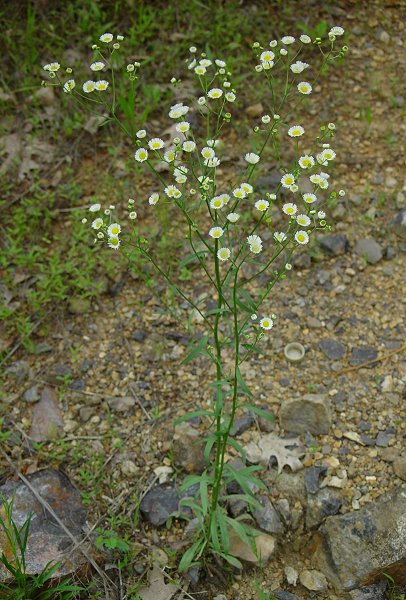Erigeron strigosus Muhl. ex Willd.
Daisy Fleabane

Native
CC = 3
CW = 3
MOC = 89
© DETenaglia
Erigeron strigosus Muhl. ex Willd.Daisy Fleabane | |
 |
Native CC = 3 CW = 3 MOC = 89 |
© DETenaglia |
|
Family - Asteraceae/Astereae Habit - Annual or biennial forb, with shallow, fibrous roots. Stems - Erect, to 70 cm, 1 to several, often well branched above the lower 1/3, sparsely to moderately pubescent with appressed to ascending hairs, sometimes in lines.
Leaves - Basal and alternate. Basal leaves sometimes withered by flowering time, 3-15 cm long, mostly long-petiolate, the blade elliptic-oblanceolate, mostly long-tapered at the base, mostly pointed at the tip, the margins entire or coarsely toothed usually above the midpoint, the surfaces and margins sparsely to moderately pubescent with short, relatively stiff hairs. Stem leaves usually appearing relatively few (this mostly because the leaves are sparser toward the stem tip), 1-10 cm long, the lower ones short-petiolate, the median and upper ones reduced, sessile, the blade linear to oblanceolate, angled or tapered to a mostly sharply pointed tip, short- to long-tapered at the base, not clasping the stem, the margins entire or with few irregular teeth toward the tip, the margins sparsely hairy, the surfaces antrorse strigose.
Inflorescences - Loose, rounded to flat-topped panicles, often with numerous heads.
Heads - Flower heads to 1.5 cm broad. Peduncles antrorsely strigose. Involucre 2-5 mm long, the receptacle 4-12 mm in diameter at flowering, the phyllaries imbricate, usually pubescent with short, appressed and/or longer, more or less spreading hairs, often also minutely glandular. Disk to 7.5mm broad.
Florets - Ray florets 50-100, the corolla 4-7 mm long. Disc florets with the corolla 1.5-2.5 mm long. Pappus of the ray florets and disc florets of 2 types, an inner series of 8-15 threadlike bristles 1.2-2.2 mm long and an outer series of several shorter bristles or slender scales 0.1-0.4 mm long, the ray florets lacking the longer, inner series.
Fruits - Achenes 0.8-1.2 mm long, sparsely and inconspicuously hairy. Flowering - May - September. Habitat - Forest openings, streambanks, savannas, prairies, and glades, pastures, fields, railroads, roadsides, open disturbed areas. Origin - Native to the U.S. Lookalikes - Other species of Erigeron, especially E. tenuis and E. annuus. Other info. - This plant is common throughout Missouri. Beyond Missouri it is common in the eastern half of the continental U.S., more scattered but still present in most western states. The plant is easily recognized as an Erigeron by its prolific flowering heads having numerous white rays. These can be almost bristly in appearance, making the heads look a bit like chimney sweeps. E. strigosus is differentiated from most other Missouri fleabanes by its narrow leaves which are tapered at the base. It is not as weedy as the more common E. annuus (L.) Pers., which is taller, has broader leaves, and has larger flower heads, though occasional specimens can be difficult to distinguish. Photographs taken on Taum Sauk Mountain, MO., 5-31-03 (DETenaglia); also at Shaw Nature Reserve, Franklin County, MO, 5-18-2007, and at St. Joe State Park, St. Francois County, MO, 5-17-2018 (SRTurner). |